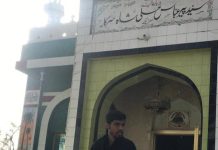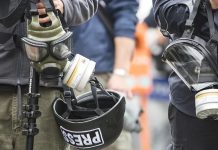Karachi: Every morning, instead of leaving for work, 40-year Farhan Ahmed has to fetch water for his family of four as he fears that his two youngest children will suffer from dehydration due to the severe heat. He resides in a coastal slum in Pakistan’s largest city, Karachi. Ahmed is often late for work because he has to procure water for his family.
Karachi is experiencing severe heat waves and water scarcity. Ibrahim Hyderi, the area where Ahmed lives, is said to be the oldest slum in the city; it has no access to water as the state-run department is not providing pipe water to the area, claiming that it is too far from the city centre and it is not even registered in their records. Water is scarce and several other coastal towns just like this one, are deprived of drinking water during the scorching days of summer.
Last week, a large number of slum dwellers took to the streets under the burning sun to protest against the scarcity of water. A large number of women and children were accompanying the protesters. “Protests against water shortage are very common in the area,” said Kamal Shah, a social worker.
The area is suffering acute shortage of water due to ethnic differences. Authorities responsible for the provision of water are biased and they ignored the residents on the shore based on their ethnic background. “The governments in the past neglected the area due to ethnic discrimination,” said Shafi Muhammad Jamot, a member of the provincial assembly of Sindh, while talking to News Lens Pakistan.
In Karachi, the poor women and children are the primary victims of the water shortage, especially those living in underprivileged areas. Due to this scarcity of water, several people from such underdeveloped areas died during the heat-wave that hit Karachi in 2015.
A deadly heat wave hit Karachi in the summer of 2015, killing over 1300 people in three days. The vanishing sea breeze and the acute water shortage further contributed to the catastrophe.
“We received 250 patients who suffered from a heatstroke on the first day alone. Over 10,000 patients had been treated for a heatstroke during 2015 heat wave that hit the city,” Dr Seemi Jamali, Executive Director of Karachi’s biggest public hospital, the Jinnah Postgraduate Medical Centre (JPMC) told News Lens Pakistan on phone.
Karachi is an arid region and farther away from the Indus eco-region. Hence, it has less water. There are around 166 hamlets like Ibrahim Hyderi scattered along 129 kilometers of Karachi’s coast which have no access to drinking water. Water tanker owners supply these areas on a commercial basis, but most of the people fetch water from a different destination and store it.
A research study conducted by Orange Pilot Project (OPP) in 2014 reveals that 7 million residents of underprivileged areas in Karachi have no access to drinking water.
Karachi Water & Sewerage Board (KWSB) is the only state-run department in Karachi which provides drinking water to the 20 million people of Karachi and according to KWSB’s official data, the city needs 1100 million gallons per day (MGDs), but it gets only 500 MGD, less than 50% required quantity of water to city.
“To ensure access to drinking water during heat waves, we have made special arrangements to provide water across the city, and we have established one hundred seventy one first response centres to provide medical aid to those affected by heat strokes,” said Syed Asif Hyder Shah, Commissioner Karachi and also the head of KWSB.
However, officials of the provincial government of Sindh-of which the Karachi is capital city- justify their position saying that water is unavailable, hence, these areas are not provided with water. “Owing to decreased rainfall over the past few years, the dams were not filled enough, due to which we are not getting sufficient water for Karachi. Therefore, we are unable to provide water to shore residential areas of the city, however, during the upcoming heat wave we have ensured water supply to these areas,” said Dr. Sikander Ali Mandhro, Minister for Coastal Development Authority, Sindh.
Managing Director of Karachi Water & Sewerage Board (KWSB) Misbah-ud-din Fareed, who resigned Monday for personal reasons when this story was being published, said, “We have an insufficient amount of water, which is not enough to supply all areas of city. The city has a 50% shortage of drinking water and the percentage continues to increase due to an increase in population. KWSB have no current plans for a supply pipeline to coastal areas.”
Government of Sindh has launched a K-4 project for the city, which supplies 650 MG of water per day. The project will be completed in three phases, and the completion of the first phase is scheduled for 2018, he added.
Most of the people living on the shore of Karachi are fishermen. Pakistan Fisher Folk Forum (PFF), a non-governmental organization, works for their welfare. President of PFF, Muhammad Ali Shah said, “These areas have been facing an acute shortage of water for the past few decades. The heat waves during summer only serve to double their woes. Our organization PFF approached the concerned authorities time, and time again, people protested, but the authorities were indifferent and failed to give a positive response.”
He said, “Residents living along the coastal belt were deprived of drinking water during the 20th century, and this trend has continued in the 21st century as well.” He added, “There is no doubt that all of Karachi is already facing a shortage of water, but these areas are being ignored due to the ethnicity of their residents.”



